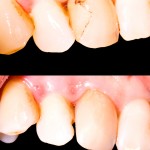
With reductions in the prevalence of caries in many countries the number of anterior teeth requiring restoration has fallen and in some countries more anterior teeth require restoration as a result of trauma than caries. The aim of this review was to assess the effectiveness of anterior resin restoration in class III and class IV cavities.
Methods
Searches were conducted in the Scopus and PubMed databases for prospective studies on Class III/IV restorations in permanent teeth with a minimal 15 restorations and follow up of 2 years. Studies on direct composite veneers and studies using composite materials to correct the vertical dimension were not included.
Results
- 21 studies were included; 14 for class III restorations, 6 for class IV restoration and 1 for diastema closure.
- 22 different composites, 3 compomers and 2 glass ionomer derivatives and 15 different adhesive systems were used in the studies.
- The estimated median overall success rate (without replacement) after 10 years for Class III composite resin restorations were 95% and for Class IV restorations 90%.
- The main reason for the replacement of Class IV restorations was bulk fractures, which occurred significantly more frequently with microfilled composites than with hybrid and macrofilled composites.
- Caries adjacent to restorations was infrequent in most studies and accounted only for about 2.5% of all replaced restorations after 10 years irrespective of the cavity class.
- Class III restorations with glass ionomer derivatives suffered significantly more loss of anatomical form than did fillings with other types of material. When the enamel was acid-etched and no bonding agent was applied, significantly more restorations showed marginal staining and detectable margins compared to enamel etching with enamel bonding or the total etch technique; fillings with self-etching systems were in between of these two outcome variables.
- Bevelling of the enamel was associated with a significantly reduced deterioration of the anatomical form compared to no bevelling but not with less marginal staining or less detectable margins.
- The type of isolation (absolute/relative) had a statistically significant influence on marginal caries which, however, might be a random finding.
Conclusions
The authors concluded:
– The absolute failure rate of anterior restorations in general was relatively low.
– Class IV restorations showed more fractures than Class III restorations
– The overall performance of hybrid composites was better than that of microfilled composites.
– There was a consistent decrease in color match independent of the type of material.
– When the enamel was etched with phosphoric acid, less discoloration at the restorative margins was observed compared to restorations that involved other conditioning systems.
– Caries adjacent to the restoration was infrequent and not related to any factor evaluated except for the type of isolation.
– Bevelling of enamel had no significant influence on the out – come variables except for the anatomical form, which might be a random finding.
Comments
This review brings together the results of a wide range of anterior filling materials and bonding systems. As the authors note the majority of the included studies were carried out between 1980 and 2000 and some of the materials investigated are no longer on the market. In terms of the conduct of the review it is not stated whether study selection was carried out independently or whether the individual studies were assessed for quality. While information on the number of restorations is provided no information on the number of patients is provided, so it seems unlikely that the impact of clustering has been considered. The wide range of materials and adhesive systems identified also provides a challenge.
Links
Heintze SD, Rousson V, Hickel R. Clinical effectiveness of direct anterior restorations-A meta-analysis. Dent Mater. 2015 Mar 12. pii: S0109-5641(15)00044-5. doi: 10.1016/j.dental.2015.01.015. [Epub ahead of print] Review. PubMed PMID: 25773188.

Don’t miss – Direct anterior restorations – good survival rates http://t.co/LnlwaqFI53 #EBP